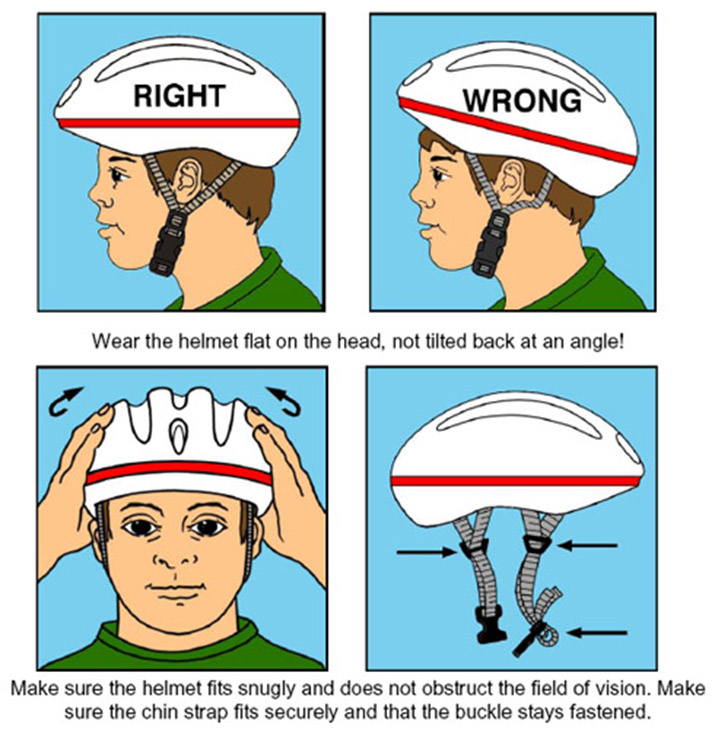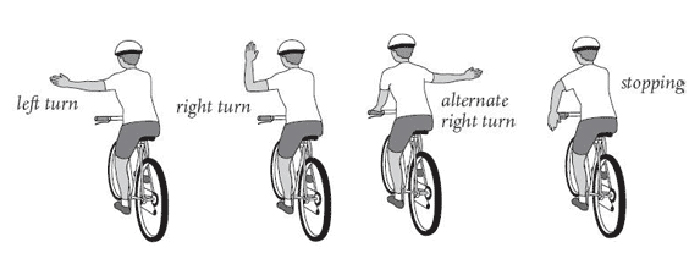Everyday Trauma Prevention
Bicycling Safety and Proper Helmet Use
Bicycling Safety and Bicycle Helmet Use
Bicycle crashes and improper helmet use can cause traumatic injuries.
Statistics
- There are more biking-related injuries seen in the hospital emergency departments in the United States every year than ANY other sports-related injury
- In the U.S., recent figures indicate that more than 700 people are killed annually while biking
- Young adults (ages 15-24) and adults (age 45 years and older) are at the highest risk for bicycle-related injury and death
Helmet Use
- Wear a helmet. It is the most effective thing you can do to prevent head injury and death
- California law requires anyone under the age of 18 to wear a helmet when riding a bicycle, whether pedaling or as a passenger
- Allow your child or teen to pick out their own helmet and make sure they use it EVERY time they ride a bike
- It is recommended that adults wear a helmet, too. It is the most effective thing you can do to prevent head injury and death
See the Proper Helmet Use PDF >
Fitting a Helmet
- The helmet should not be tilted back but should instead cover the forehead (see illustration)
- The helmet should fit snugly. The straps should meet right under the ears to form a Y (see illustration)
- The strap should be tight enough that if the mouth is opened wide, it will pull the helmet downward. No more than two fingers should fit under the strap
General Bicycle Safety
- Ride in a straight line
- Ride with traffic, not against it (Some people mistakenly think they are to bike against traffic, because it is correct to walk against traffic)
- Use hand signals
- Wear bright colors during the day and reflective materials at night
- If you wear headphones when biking, always leave one ear uncovered
- Obey traffic signs, signals, and laws (Bicyclists share the roads, rights, and rules with motor vehicle drivers )
- If biking at night, California law requires use of numerous reflectors and a front light. See details in the Summary of California Vehicle Code for Bucyclesin the Resources section below
Children
- Children under the age of approximately 13 are generally not able to bike safely in a public street
- Sidewalk riding has its own dangers. Teach children about sidewalk safety, including that driveways and intersections can be hazardous, since drivers are not typically looking for a bicyclist to be coming off a sidewalk
- Role model safe behavior, including wearing a helmet yourself
- When children are sitting on a bike seat, their feet should be able to touch the ground
- Teach your child to stay alert for any moving vehicle (including silent electric vehicles), to make eye contact with drivers, and other safe riding practices (See Resources section below)
Driver Tips
- Bicycles do not need to stay in bike lanes. Bikes are considered vehicles
- Be especially alert in residential neighborhoods and school zones
- Enter/exit driveways slowly and carefully. Check behind your vehicle before backing up
- Look behind you for approaching bicycles before opening your car door
- Don’t honk unless necessary to avoid a collision. It may startle a bicyclist and cause a crash
Distracted Travel
- Put cell phones and other distractions out of sight. Whether driving or biking, California law states: ban on handheld cell phones for all drivers and bicyclists; ban on handheld or any cell phone for drivers and bicyclists under 18; ban on texting for all drivers and bicyclists. (And remember that when walking or skating, distracted travel is also dangerous)
Resources
Websites
Videos
How-to-Video: the Bike Helmet Fit Test
The Rights and Duties of Cyclists – Bicycle Safety
Promote Bike Helmet Safety
Natividad is committed to community education and awareness in order to reduce trauma-related injuries due to unsafe helmet use.
To schedule a helmet safety presentation for your students (appropriate for ages 6-12) at no charge, please contact the Trauma Prevention and Outreach Nurse at (831) 772-7357 or artingerlg@natividad.com.
The purpose of the class:
- Encourage safe helmet use
- Basic traumatic brain injury education
- How a helmet functions to protect the brain
- How to select and fit a helmet properly
Distracted Driving
What is Distracted Driving?
Any activity that takes a person’s attention away from their primary task of driving.
Statistics
- 1 of every 10 fatal crashes in the United States involves distraction
- You’re three times more likely to crash if you text while driving
- In 2012, 421,000 people were injured in car crashes involving a distracted driver
- When you text, your eyes are off the road for an average of five seconds. If you’re driving at 55mph, that’s the length of a football field
- Every minute, approximately 660,000 drivers are using their cell phones or electronic devices while driving
- 49% of drivers under the age of 35 text while driving
- 42% of young adult drivers believe that they can safely text while driving
What can You Do?
- Simplest option: Don’t text and drive
- Pull off safely to the side of the road to text
- Don’t be tempted. Turn your phone off before driving
- Put the phone where you can’t reach it
- Have a passenger in your car send the text for you
- Don’t text friends when you know they’re driving
- Download a safe-texting app: AT&T Drivemode, textecution, Safely Go App
Resources
Websites
Videos
“From One Second To The Next” A Film By Werner Herzog – It Can Wait | AT&T
Falls
Falls can be serious at any age, but have an especially negative impact on the well-being and independence of older adults. Many falls are preventable; take steps to protect yourself and loved ones.
Statistics
- Falls are a leading cause of trauma and injury among people aged 65 and older
- One-third of adults aged 65 and older fall every year
- Half of all falls happen at home
Why Do People Fall?
Most falls are due to a combination of risk factors such as:
- Weakness, slow reflexes or balance problems
- Illness, poor vision, memory problems or certain medications
- Tripping hazards in the home or wearing improper footwear
- Drinking alcohol
Tips to Prevent Falls
Exercise
- Maintain your strength and balance
Manage Your Medications and Talk to Your Doctor
- Have your pharmacist or doctor review all of your medications to identify medications that may make you dizzy or sleepy
- Tell your doctor if you’ve fallen
Have Your Vision Checked Every Year
- Poor vision or improper eyewear can increase your chances of falling
Make Your Home Safer
- Keep your home safe by identifying and removing potential fall hazards
- Refer to the Home Safety Checklist below
- Clean up spilled liquids right away
- Don’t walk in the dark
Home Safety Checklist
- Stairs, hallways and pathways are free of clutter, cords and magazines/books/papers
- Sturdy handrails are installed on both sides of all staircases
- Grab bars are appropriately installed in the bathtub or shower and by the toilet
- Non-slip mats or strips are present in the shower or bathtub
- Raised toilet seats are installed
- Bright light bulbs are installed throughout your home
- A lamp and flashlight are within easy reach of your bed
- Night lights are present in bedrooms, bathrooms, stairwells and hallways
- Small throw rugs are removed or secured with double-sided tape
- Items that you use often are within easy reach
- Always wear sturdy, low-heeled, well-fitting shoes both inside and outside of the house
Impaired Driving
Impaired driving can cause a traumatic injury. For your safety and the safety of others, please do not drink and drive.
Statistics
- Almost 30 people in the United States die EVERY day in crashes that involve alcohol-impaired drivers. Young people are most at risk
- Approximately one-third of people living in the United States are involved in an alcohol-related crash at some point during their lives
- In the year 2012 alone, 7,132 deaths in the United States could have been prevented if alcohol-impaired drivers were kept off the road
What Does Alcohol Do to Your Body?
- Alcohol is a depressant. It slows down your nervous system and brain
- Alcohol affects the area of your brain that controls thinking and decision-makingAlcohol slows reflexes, reaction times, and distance judgement
Laws
- The law states it is illegal for a driver’s blood alcohol concentration to exceed 0.08% (80mg of alcohol per 100ml of blood). Drivers younger than 21 must not exceed 0.01%
What you Need to Know
- BEFORE you start drinking, plan how you’re getting home
- It is difficult to estimate your blood alcohol level, because it depends on many factors
- DO NOT drive if you’ve been drinking
- Don’t let your friends drive if they’ve been drinking. Take away their keys
- Stay where you are until you are sober
- Only ride with sober drivers
- Assign a designated driver
- Plan on calling a taxi or taking public transportation
- Have a back-up plan
Resources
Websites
Videos
What Does Statistics Says About Drunk Driving — Community Education at Pulse Uniform
Pedestrian Safety
Statistics
- A pedestrian injury occurs every eight minutes. EVERY one of these injuries is preventable
- The greatest number of fatalities in the United States are in California
- Pedestrian injuries are the fifth leading cause of death in the United States for youth ages 5-19. Teen pedestrians are most at risk
Pedestrian Tips
- It is safest to walk on sidewalks or paths. If you MUST walk on the street, always walk facing traffic
- Cross the street at street corners, using crosswalks and traffic signals
- Make eye contact with drivers
- Put down devices, such as cell phones and electronics, take off your headphones, and look left, right, and then left again before stepping into the street
- Children under age 10 should cross the street with an adult
- Increase your visibility at night by carrying a flashlight and wearing reflective clothing
Resources
Websites
Videos
“Moment of Silence” Teens Distracted by Mobile Devices While Walking
Safety Seats
Properly using a safety seat and buckling up the right way on EVERY car ride is the most important thing a family can do to stay safe in the car.
Statistics
- Car crashes are the number one preventable cause of death for children and young adults in the United States
- Car seat use reduces the risk of death for infants by 71% and for toddlers by 54%. Seat belt use by older children and adults reduces risk of death and serious injury by about 50%
Proper Safety Seat Use
- Find a safety seat that fits your child’s age and size (check the exact height and weight limit on the side or back of your safety seat)
- Check your safety seat’s expiration date. Most expire within six to nine years
- Your child should be in a rear-facing safety seat for as long as possible, usually until around age 2 with a weight of at least 20 pounds
- Use a front-facing seat until the harness no longer fits, or your child’s weight and/or height exceeds the seat’s limits, generally until age 5
- Children should be in a booster seat until they weigh between 80 and 100 pounds and are at least 4’9,” usually around age 8. Your child may then switch to a safety belt
- Children should ride in the back seat until age 13
Car Seats
- Know how to install and use your car seat correctly every time. Read the car seat instructions AND your vehicle owner’s manual
- Car seats should be placed in the back seat of your vehicle
- Once the car seat is secured, it should not move side-to-side or front-to-back more than one inch
- Chest clips should be fastened at the armpit level
- Tighten the straps until you are unable to pinch extra material from the shoulder strap
Booster Seats
- Read the booster seat instructions and your vehicle owner’s manual
- Place the booster seat in the back seat
- Have your child sit in the seat and make sure the belt fits properly. The belt should sit across the child’s upper thighs (not stomach), and the shoulder belt should cross the chest. DO NOT place the shoulder belt under the child’s arm or behind their back
Resources
Websites
Videos
Bubble Wrap: Having Trouble Installing Your Car Seat? We Can Help.
Safe Kids Austin – Booster Seat PSA
Car Seat Resources in Monterey County
AAA
Car seat inspection station. Call for appointment.
53 Soledad Dr.
Monterey, CA 93940
(831) 645-1920
California Highway Patrol
Car seat inspection station. Call for appointment.
King City: 2 Broadway Circle, King City, CA 93930. (831)-385-3216
Salinas: 960 E. Blanco Rd, Salinas, CA 93901. (831) 796-2100
Hodges Rental Center
Loaner car seats. $22.50/week
456 Lighthouse Avenue
Monterey, CA 93940
(831) 373-7368
Laurel Family Practice
Patients only. Low-cost or free car seats. Handouts, instruction on car seat use/installation. Spanish available.
1441 Constitution Blvd
Salinas, CA 93906
(831) 755-4123
Monterey County Association of Families
Caring for Children through Department of Social Services
Welfare clients only. Free car seats. Spanish available.
1000 South Main Street, Suite 112
Salinas, CA 93901
(831) 796-1599
Monterey County Operated Health Clinics:
Patients only. Free or low-cost car seats. Handouts, instruction on car seat use/installation. Certified car seat technician. Spanish available.
Alisal Health Clinic: 559 East Alisal St, Suite 201. Salinas, CA. 93905. (831) 769-8812
Marina Health Clinic: 3155 De Forest Rd, Marina, CA. 93933. (831) 384-1445
Seaside Health Clinic: 1150 Fremont Blvd, Seaside, CA. 93955. (831) 899-8100
Monterey County SAFE KIDS Coalition
Discounted car seat program, call for schedule. Car seat inspection and community awareness. Spanish available.
David Maradei, Director, Child Abuse Prevention Council for Monterey County
1000 South Main Street Suite 112
Salinas, CA 93901
831-755-3404
Monterey Adult School
Two-hour education class, video, handouts, demonstrations, and inspection/installation. See schedule. $45/class.
1713 Broadway Ave.
Seaside, CA 93955
(831) 392-3565
Natividad Volunteer Auxiliary
Patients only.
1441 Constitution Blvd.
Salinas, CA 93906
(831) 755-4215
Presidio of Monterey Police Station
Car seat inspection and installation. Call for appointment.
Building 4468 Gigling Rd.
Seaside, CA, 93955
(831) 242-7851
Presidio of Monterey Fire Station
Car seat inspection and installation. Call for appointment.
4400 General Jim Moore Rd
Seaside, CA 93955
(831) 242-7701
Salinas Valley Memorial Hospital
Patients only. Video, handouts, $35 fee, car seats for sale. Spanish available.
450 East Romie Lane
Salinas, CA 93901
(831) 757-4333 ext. 2125






